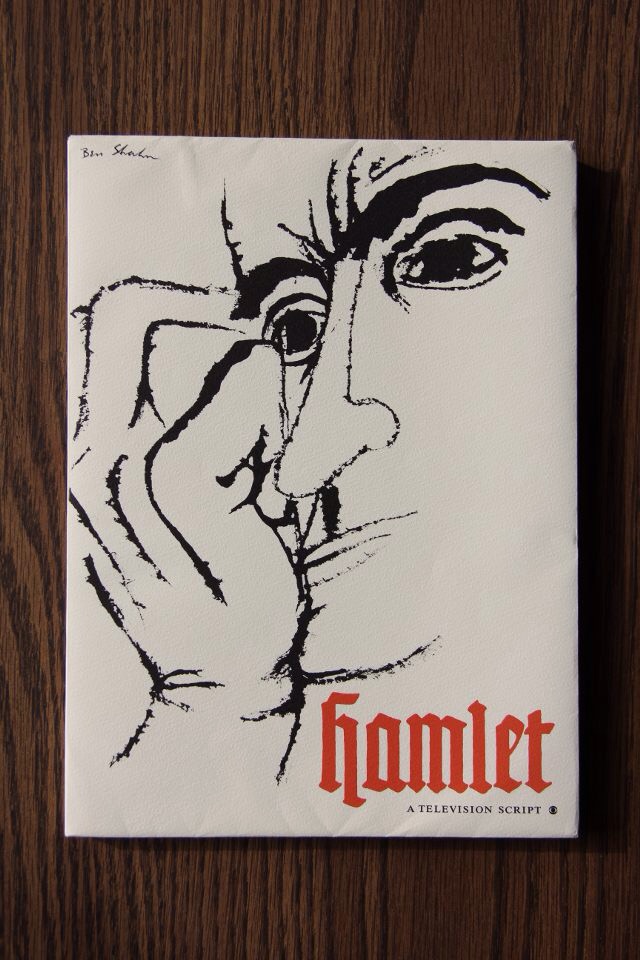HamTV
Hamlet: A Television Script is a tall thin script bound like a book. The work was published in 1954. This item is more of a book than a script. It even contains illustrations like a book. This is something more for personal enjoyment rather than the actual script of an actor. The cover is white with red and black writing. The illustrations are by Ben Shahn and depict different scenes and characters every few pages. All of the illustrations are done in black with simple lines resembling brush strokes. Something to note is the lack of page numbers as well as line numbers, something any regular script requires. This script was adapted for the CBS television series Hamlet, which aired in 1959. The odd things about this book is the fact that the title claims that it is a television script, but it is not written in the format of a screen play. The spoken lines are all in black, but the stage directions are in red. Most scripts are all in black with parenthesis or italics to signify stage directions. This book was more of a printed reference for the final script rather than the script for the television production.

In our group’s creative interpretation of Hamlet: A Television Script (1954), we decided to shoot a scene from the script for a short video. We discussed what style we wanted to shoot it in and we thought that it would be fun and interesting if we shot it in sitcom style (e.g., bright lighting, three-point camera, studio laughter added in post, etc...) This may seem odd seeing as how Shakespeare’s original Hamlet is a tragedy, but our group decided to bring something modern to the text by depicting it through the lens of dark comedy. In keeping with our pledge to modernize the text, we also decided that the character of Prince Hamlet would be gender-bent to become Princess Hamlet, thus making Hamlet and Ophelia two Queer women in a relationship with each other. Additionally, on top of shooting our scene in sitcom style, we decided to shoot it specifically in the style of the popular 90s sitcom Seinfeld to produce what we call Hamfeld. In our creative interpretation, Hamlet’s monologue at the beginning of the scene is reimagined as one of Jerry’s standup bits as seen in the beginning of most Seinfeld episodes. After Hamlet’s monologue/standup, the scene cuts to the interior of her apartment, adorned to bear a resemblance to Jerry’s apartment on the original Seinfeld set. Ophelia, standing in as Elaine, walks through the door and the two speak to each other with their original lines, but delivered as the trademark banter that for which Seinfeld is known. In the scene, Claudius and Polonius are eavesdropping on Hamlet and Ophelia, so for our creative interpretation we reimagined these characters as Kramer and Newman, respectively. Because Claudius enters the scene so abruptly in the original text, it is fitting that he would fill Kramer’s role, as Kramer is known for entering rooms in an abrupt and chaotic manner. We even add in a snarl from Hamlet as she addresses Polonius with disgust in the same way Jerry speaks to Newman (“Hello, Polonius.”)
We chose to reimagine our item this way because Hamlet has such a profound and complicated history with several interpretations (either directly adapted from or inspired by) so we wanted to contribute to this rich history with an interpretation that is unique from any other Hamlet adaptation. The goal in the original item was to adapt the well-known story of Hamlet into the more modern format of television in order to cater to mainstream audiences of the time. Because the original item operates in this way, we found it appropriate to respond with even more modernization while still keeping the original text intact. By combining the canonized original Shakespeare play, this adapted television script, and the postmodern 90s sitcom staple Seinfeld, we hope to demonstrate the ways in which creative works spanning across several decades and centuries can still be in communication with each other and reveal aspects in one another that might have gone unnoticed before.